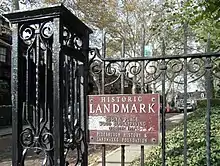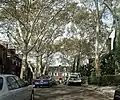 | |
 Location of Roslyn Place in Pittsburgh | |
| Location | 506-523 & 525 Roslyn Place (Shadyside (Pittsburgh)), Pittsburgh, Pennsylvania, USA |
|---|---|
| Coordinates | 40°27′12.74″N 79°56′9.94″W / 40.4535389°N 79.9360944°W |
| Built/founded | 1914-1917 |
| Architect | Thomas Rodd |
| Governing body/ | Numerous Private Owners |
| CPHD designated | March 20, 2018[1] |
| PHLF designated | 2000 |
Roslyn Place is a collection of houses located at 506-523 & 525 Roslyn Place in the Shadyside neighborhood of Pittsburgh, Pennsylvania. Built between 1914 and 1917 in the Colonial Revival and Georgian Revival architectural styles, the houses currently serve residential functions.
History
Until the late 1800s the area that would become Roslyn Place was a lot owned by J.W. Friday. It included a single wooden house surrounded by four wooden outbuildings. By 1904 the property was owned by Thomas Rodd, and the adjacent land to the southwest was owned by M.W. Rodd and served as the home of the Rodd family. Thomas Rodd was born in London, England and immigrated to the United States at the age of 5, and he served as an officer in the Navy during the American Civil War.[2] Shortly afterwards he eventually joined the Pennsylvania Railroad Company where he would be appointed to chief engineer for all lines west of Pittsburgh in 1889.[3] It was at this time that he moved to Pittsburgh, and the Rodd family quickly became members of Pittsburgh's social elite.[4] He joined the Pittsburgh Club, the Duquesne Club, the Allegheny County Club, the Pittsburgh Golf Club, the University Club of Pittsburgh, the Metropolitan Club of New York, and the Chicago Club.[5] The Rodd family was of such social status that even their vacations and work travel were reported in prominent newspapers.[6][7][8][9] Thomas Rodd also played a role in the construction of many buildings in western Pennsylvania and the Midwest, and he was responsible for designing and constructing Roslyn Place. Rodd was also responsible for constructing the historic street which the houses sat on, also called Roslyn Place. In 1914 construction began when the City Council passed ordinance No. 181, which approved of Rodd's plans for the creation of Roslyn Place.[10] In the same year the City Council passed ordinance No. 240, which authorized the purchase of a water pipe line connecting to Roslyn Place.[11] This is representative of the progress and modernization that occurred with the new development. The construction continued for the next two years and finished in 1917, and the advertisements of the new development were published.[12] The houses in the constructed neighborhood served as mainly rental properties owned by the Rodd family until the 1950s when the individual homes were sold. The houses continue to serve residential functions and the Roslyn Place neighborhood was nominated in October 2017 to become a City Historic District by Preservation Pittsburgh.
Architecture
The district was designed by Thomas Rodd in the Colonial Revival architectural style, with significant Georgian Revival influences. Examples of the Colonial Revival style are rare within the City of Pittsburgh. The scale, uniformity, and quality of design are what make Roslyn Place's Colonial Revival elements exceptional.[13] Roslyn Place also has significant Georgian Revival elements, and these can be seen with the symmetrical facades, the hemispherical hoods, the pediment porches, the use of brick, and the coffered design elements on the porches and hoods. The street Roslyn Place is also notable as an example of Nicolson pavement. The neighborhood's design and planning approach is widely recognized, most notably by acclaimed urban planner Allan Jacobs.
Gallery
 Photo of some of the houses in Roslyn Place
Photo of some of the houses in Roslyn Place Photo of the Historic Landmark sign on the entrance to Roslyn Place
Photo of the Historic Landmark sign on the entrance to Roslyn Place Photo of the Road and entrance to Roslyn Place
Photo of the Road and entrance to Roslyn Place
References
- ↑ "Bill No. 2018-0053". City of Pittsburgh. Retrieved December 3, 2020.
- ↑ Thomas Rodd. The Book of Prominent Pennsylvanians: A Standard Reference. Pittsburg Leader. Leader Publ., 1913.
- ↑ "Roslyn Place Nominated to become a City Historic District". Preservation Pittsburgh. 25 October 2017. Retrieved 2018-06-30.
- ↑ Chief Engineer Thomas Rodd, The Pittsburgh Post, April 14, 1900.
- ↑ Sport at the Links, Pittsburgh Commercial Gazette, July 18, 1898.
- ↑ Mr. and Mrs. Thomas Rodd, The Pittsburgh Press, July 3, 1894.
- ↑ Lakewood is Booming, The Pittsburgh Press, July 11, 1897.
- ↑ White Sulpher Springs, The Pittsburgh Press, August 24, 1896.
- ↑ Capt. And Mrs. J.J. Vandergrift, The Pittsburgh Press, February 15, 1897.
- ↑ Official Pittsburgh, No. 181, The Pittsburgh Post. May 30, 1914.
- ↑ No. 240, The Pittsburgh Post, July 13, 1914.
- ↑ Lots, The Gazette Times, Pittsburgh, August 30, 1913.
- ↑ Colonial Revival Style 1880-1960, Pennsylvania Historical & Museum Commission, Accessed on September 16, 2017.